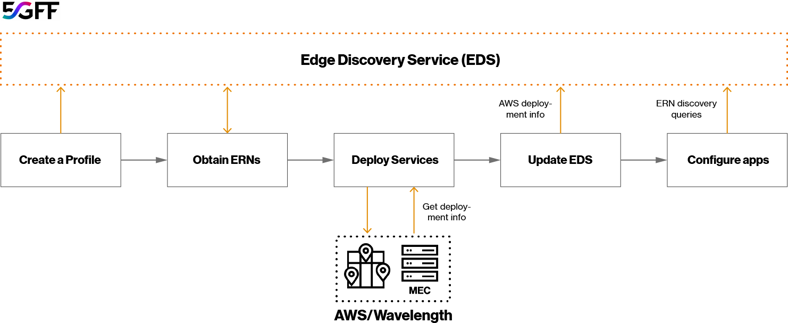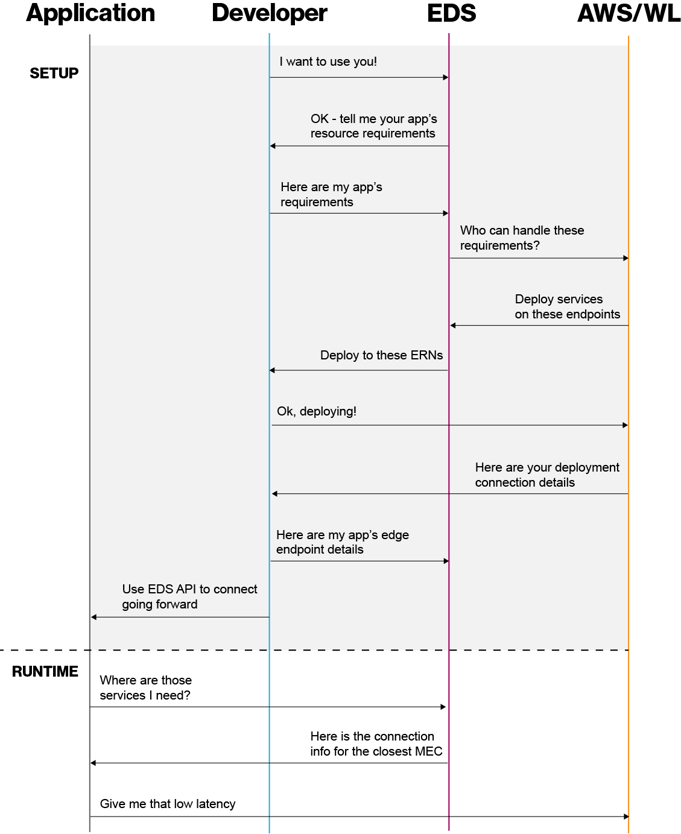EDS API
"What is the Edge Discovery Service (EDS)?"
The Edge Discovery Service (EDS) API identifies the most efficient, performant 5G Edge servers for your application, regardless of client device location. The 5G Edge location that is geographically nearest to a client device might not always be the optimal endpoint for various reasons. EDS considers several factors, such as the current location of a device, its IP anchor location, current network traffic, and other metrics, to determine the most suitable 5G Edge platform for a device to connect to.
To benefit from the Edge Discovery Service, follow these four steps:
- Utilize the EDS API to discover the ideal 5G Edge zones for your application requirements based on your region and a profile you create, which includes resource requirements, user devices, number of subscribers per square kilometer, or a combination of these factors.
- Deploy your application services to the 5G Edge zones recommended by EDS.
- Register your application's Edge endpoints with EDS.
- Update your client code to use EDS APIs to identify the appropriate Edge server to connect to.
To explore the technical advantages of the EDS API further, read this post from Verizon.
"What advantages does the combination of 5G Edge and EDS offer?"
- Near real-time application responsiveness
- More efficient network device operation
- Blazingly fast data transfer speeds and low latency
- Access to advanced network services and benefits
By leveraging AWS Wavelength Zones, 5G Edge optimizes AWS compute resources and brings them closer to users than ever before. With AWS compute and storage services, Wavelength Zones offer seamless access to a range of AWS services in your region, including Amazon S3, Amazon RDS, and Amazon DynamoDB, similar to Availability Zones.
Moving your application to the edge can provide you with the following benefits:
- High transfer speeds and low latency networking provided by 5G, and
- Near real-time responsiveness for complex processes that would otherwise require running on a client device to achieve the same performance.
This reduces power consumption, battery drain, and processing demands on client devices. Moreover, allowing updates to take place on the edge servers instead of pushing a new version to all client devices simplifies application updates.
In addition to throughput and data volume, 5G presents significant advantages to developers in terms of the end-to-end latency of their applications. For example, in a computer vision use case, a 5G device can upload a 1MB image approximately 25 times faster than a 4G device.
To put it simply, with 5G Edge, developers can take advantage of the advanced features of the 5G network without needing to navigate the intricacies of network management and operation. As the 5G network evolves and introduces new features, like low latency, high throughput, and network slicing, developers will be able to access these capabilities more seamlessly.
“Can my web application leverage EDS?"
- Gaming/VR Entertainment
- Machine Leaning/AI Computer Vision
- Autonomous Vehicles Telepresence
In partnership with AWS Wavelength, 5GFF partners offer you the capability to deploy applications and services at the edge of the 5G network. This infrastructure is specifically designed to meet the needs of applications that require low latency and/or high bandwidth, including gaming (including AR/VR), media processing, ecommerce, social media, medical image analysis, and machine learning inferencing apps.
"Is it necessary to modify my existing infrastructure in order to benefit from the 5G Edge?"
It is not necessary to deploy the entire application in a Wavelength Zone. Only those parts of the application that can benefit from being deployed in the Wavelength Zone, such as application components that require low latency, need to be deployed there.
For instance, consider a computer vision inference application - the API and inference servers are placed in the Wavelength Zone, as low-latency processing of the inference requests is one of the application design objectives. In contrast, because the corresponding web server is serving a web app (e.g. React) and does not have the same latency requirements as the inference processing, it could be hosted in the Region instead of the Wavelength Zone.
Introduction
A quick introduction to using 5G Edge Services
You develop Multi-access Edge Computing (MEC) applications because you want the lowest latency and highest throughput between your client devices and your Edge services. There’s more to it, though, than just deploying some of your application services to Edge locations and hoping devices connect to the right ones. The Edge location that is geographically closest to a client device may not be the optimal endpoint for a variety of reasons.
The Edge Discovery Service API can direct your application clients to connect to the optimal service endpoints of your Edge applications for every session. The Edge Discovery Service considers the current location of a device, its IP anchor location, current network traffic, and other factors to determine which 5G Edge platform a device should connect to.
EDS Deployment Flow
You use EDS for both setting up your AWS services and then, dynamically, enabling your applications to discover and connect to the fastest 5G Edge servers. The diagram below outlines how EDS interacts with AWS and your 5G devices.

EDS Process Flow

Other Member EDS Documentation: Coming Soon!
